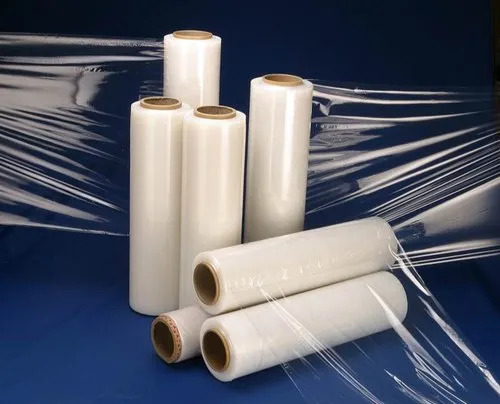When you think of plastic wrap, your first thought might be of kitchen leftovers. But did you know that plastic wrap plays a crucial role in various industries, far beyond just keeping your food fresh? From manufacturing to agriculture, this versatile material is a hidden hero, securing, protecting, and optimizing operations across the board. This blog post will unveil the many ways plastic wrap contributes to different sectors, particularly within the food industry. You’ll learn about its properties, applications, and the innovative ways it supports various functions.
Properties of Plastic Wrap
Plastic wrap is more than just a transparent sheet you use to cover food. Its unique properties make it an invaluable tool across multiple industries. First, its adherence ensures that it clings tightly to objects, providing a secure seal. Its pliability allows it to stretch and wrap around items of various shapes and sizes. Additionally, its moisture resistance is crucial for protecting goods against environmental factors like humidity and contamination.
Types of Plastic Wrap Rolls
Plastic wrap Rolls comes in several types, each tailored for specific applications. Cling wrap, for example, is commonly used in households and food service industries to keep food fresh. Stretch wrap rolls, also known as stretch film, are designed for heavy-duty tasks like bundling and securing pallets. Industrial-grade plastic wraps offer even more durability and strength, suitable for demanding environments like construction and agriculture. Understanding these different types can help you choose the right plastic wrap for your needs.
The Workhorse in Action: Industry Applications
Manufacturing and Warehousing
In manufacturing and warehousing, stretch wrap rolls are essential for securing pallets of products. These rolls ensure that items stay put during transit, preventing damage and saving space. Stretch film also protects products from dust, moisture, and other environmental factors, which is crucial for maintaining quality and reducing waste. Whether it’s electronics or fragile items, stretch wrap rolls play a significant role in keeping everything intact.
Food and Beverage Industry
The food and beverage industry relies heavily on cling wrap to maintain freshness and hygiene. Restaurants, supermarkets, and food processing facilities use it to cover and preserve various food items. Specialized plastic wraps, such as meat wrap and cheese wrap, are designed to extend the shelf life of specific food types. These wraps provide an airtight seal, preventing spoilage and contamination, which is vital for food safety and quality.
Construction Industry
In the construction industry, heavy-duty plastic wrap protects building materials, furniture, and equipment during projects. It shields these items from dust, debris, and moisture, ensuring they remain in good condition. Additionally, plastic wrap is used for waterproofing applications and creating temporary shelters, making it a versatile tool for various construction needs.
Agriculture
Agriculture is another sector where plastic wrap proves to be indispensable. Silage wrap, for instance, helps preserve forage crops for livestock feed, reducing waste and ensuring a year-round supply. Plastic mulch film is used to suppress weeds, retain moisture, and regulate soil temperature, which improves crop yield and quality. These applications highlight the critical role of plastic wrap in boosting agricultural productivity.
Retail Industry
In the retail industry, clear plastic wrap is used to showcase products on shelves, creating attractive product bundles and enhancing visual appeal. It protects delicate items during display and transportation, ensuring they reach customers in perfect condition. Whether it’s wrapping gift sets or securing fragile items, plastic wrap helps retailers maintain product integrity and presentation.
Beyond the Basics: Additional Benefits
Cost-Effectiveness
Plastic wrap is a cost-efficient packaging solution compared to other materials. Its affordability makes it an attractive option for businesses looking to reduce expenses without compromising on quality. The versatility of plastic wrap means it can be used for various applications, offering excellent value for money.
Efficiency and Ease of Use
One of the standout features of plastic wrap is its ease of application and removal. This saves time and labor costs, making operations more efficient. Whether you’re wrapping pallets in a warehouse or covering food in a supermarket, plastic wrap’s user-friendly nature ensures that tasks are completed quickly and effectively.
Sustainability Considerations
While traditional plastic wrap has raised environmental concerns, advancements in eco-friendly options are changing the narrative. Recycled materials and biodegradable films are being used to create sustainable plastic wraps that minimize environmental impact. These innovations offer businesses a way to protect their products while also being mindful of their ecological footprint.
Conclusion
The humble plastic wrap is far more than meets the eye. Its diverse applications across various industries, from manufacturing to agriculture, underscore its role as a workhorse, securing, protecting, and optimizing operations. Whether it’s through stretch wrap rolls in warehouses or cling wrap in kitchens, plastic wrap continues to prove its versatility and value. As technology advances, we can expect even more innovative uses for this essential material, further solidifying its place in our daily lives.
Ready to explore the myriad benefits of plastic wrap for your business? Don’t wait—start integrating this versatile tool into your operations today. Whether you’re in the food industry or any other sector, plastic wrap has something invaluable to offer.


